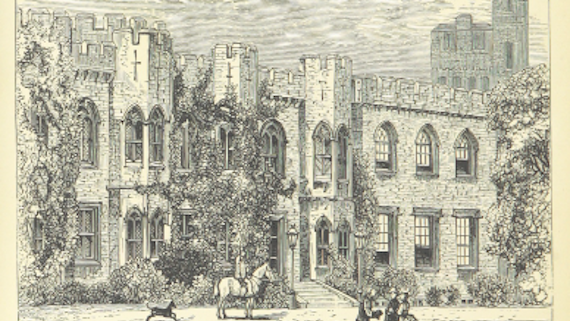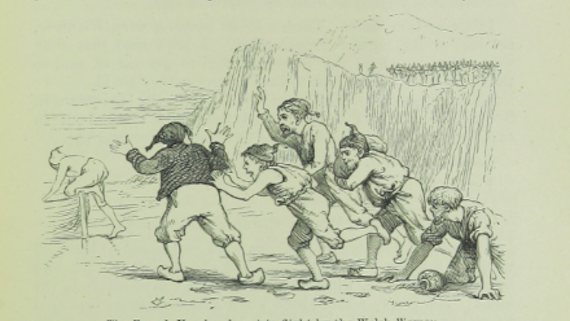Unlocking historical illustrations through digital archives
Opening up great collections means sharing whole genres with new audiences.
In her research on the intersection between the digital world and illustration studies, Professor of English Literature Julia Thomas identified that many historic book illustrations have disappeared from public view, despite the increasing digitisation of museum and gallery collections and archives.

Amid the growing risk that whole genres of artistic, educational and informative images may be lost, Professor Thomas has succeeded in creating two dynamic online archives dedicated to illustrations: The Database of Mid-Victorian Illustration (DMVI) and The Illustration Archive (IA), funded by the Arts and Humanities Research Council (AHRC). Over one million illustrations held within Cardiff University’s great book collections are now open to anyone with internet access.
Through a new approach to making illustrations searchable, these two landmark archives have succeeded in unlocking access to the world’s back catalogue of book illustrations.
This archive represents an enormous step in bringing lost and forgotten illustrations back to the attention of contemporary scholars and the public at large… The importance of digital databases in recovering the lost histories and forgotten biographies of individual illustrators, especially women illustrators, cannot be overstated.
A focused approach
The project concentrated on four key strands.
- Recognising the significance of historical illustrations and their contemporary invisibility
With illustrations holding cultural significance but ‘lost’ in print and digital forms, the Illustration Archive addresses that an understanding of this ‘illustrated world’ of the past is only possible if the images are made publicly available.
- Creating specialist illustration databases with adequate metadata for search and retrieval
The project has succeeded in building bespoke infrastructure and methodologies research that can analyse and search illustrations, including powerful image tagging analyses.
- Introducing crowdsourced image tagging as a method of public engagement and impact
Navigating the ‘politics of crowdsourcing’ with an egalitarian approach, the project places value on public ‘non-expert’ input, creating a bespoke crowdsourcing infrastructure that values all contributions, and facilitates building countless collections akin to mounting personalised exhibitions.
- Using digital methods to increase understanding of illustrations
By enabling the public to tag images for themselves, the Illustration Archive has influenced user behaviour, supporting a deeper understanding of illustrations and created a greater appreciation of place, history and culture.
Digitally harnessing the power of images
The project has generated new opportunities for the creative re-use of illustrations with users ranging from museum curators, teachers and librarians to publishers, filmmakers and television producers.
It has influenced user behaviour and perception through crowdsourced tagging. Archive users become citizen curators, recognising their ability to tag images for the public good.
It has effected changes in international teaching practice and educational understanding. Teachers globally regularly use the platforms, from as far as Australia, India and the USA. Educators have incorporated more illustrations into their teaching with increased engagement.
The project has also shaped digital infrastructure methods with its tools, methods and structures have become a model for the infrastructure of other digital illustration resources around the world. The bespoke keywording system has made a growing number of archival collections searchable by iconographic content and subject matter for the first time.
The printed pages of the 19th century are full of remarkable images, if we can find them. The Illustration Archive puts a million of them within reach. Amazing.
Global access, global significance
Worldwide, the online archives have led to changes in teaching practice and our understanding of these untapped material objects. They have generated creative re-use of historic illustrations, shaped digital infrastructure methods, and influenced user behaviour through crowdsourced tagging.
Each month, these digital archives see thousands of visits from across the world, with museum curators, filmmakers, television producers, publishers, image archive developers, teachers, artists and librarians among those discovering forgotten illustrative treasures.
Selected publications
- Thomas, J. 2017. Nineteenth-century illustration and the digital: studies in word and image. The Digital Nineteenth Century Basingstoke: Palgrave Macmillan. (10.1007/978-3-319-58148-4)
- Thomas, J. 2016. Illustrations and the Victorian Novel. In: John, J. ed. The Oxford Handbook of Victorian Literary Culture. Oxford Handbooks Oxford: Oxford University Press. , pp.617-636. (10.1093/oxfordhb/9780199593736.013.012)
- Thomas, J. 2007. Getting the Picture: Word and Image in the Digital Archive. European Journal of English Studies 11 (2), pp.193-206. (10.1080/13825570701452946)
- Thomas, J. 2004. Pictorial Victorians: the inscription of values in word and image. Athens, OH: Ohio University Press.






